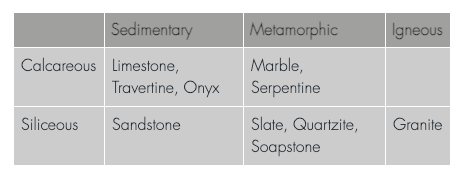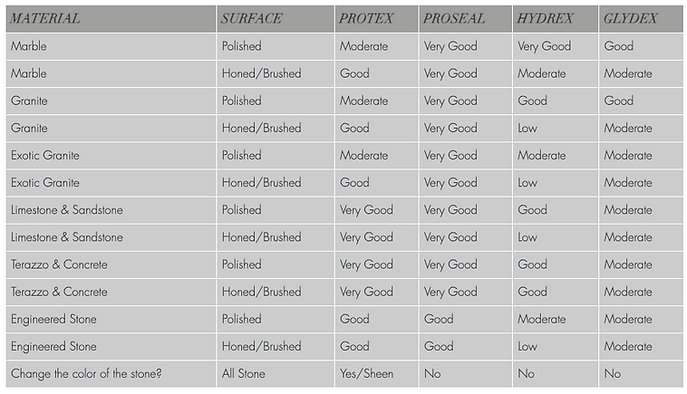
Protect your Investment
Get to Know your Stone
The first step in proper stone care and maintenance is to understand your stone’s geological classification and composition. This information will help you to identify what cleaning products to use and how best to care for your natural stone.
Natural stone is categorized into three basic geological classifications by their respective formation processes: Sedimentary, Metamorphic, and igneous. Additionally, stones in each category can be either Calcareous or Siliceous.
Calcareous stone is composed mainly of calcium carbonate, a chemical compound commonly found in natural stone, shells, and pearls. Calcium Carbonate is sensitive to acidic solutions so mild, non-acidic cleaners are recommended.
A siliceous stone, as the term implies, is one composed primarily of silicates, such as quartz, feldspar, mica, etc. as such, a siliceous stone is generally resistant to most acids found in kitchen settings, although acidic cleaners are still not recommended, as these stones may contain trace levels of minerals that are acid sensitive. others.
The following chart will be a helpful guide:

Easy Care Tips
To get the longest life and preserve the beauty of your natural stone, follow these simple tips:
COASTERS: Use coasters under all glasses, particularly those containing alcohol or citrus juices.
TRIVETS: While many stones can withstand heat, the use of trivets or mats is recommended.
DUST MOPPING: Dust mop interior floors frequently using a clean non-treated dry dust mop. Sand, dirt, and grit are abrasive and can damage natural stone.
MATS & RUGS: Mats or area rugs inside and outside an entrance will help to minimize the sand, dirt, and grit that may scratch the stone floor. Be sure that the underside of the mat or rug is a slip-resistant surface.
VACUUM CLEANERS: If used, be sure the metal or plastic attachments or the wheels are not worn as they can scratch the surface of some stones.
SPILLS: Blot the spill with a paper towel immediately. Don’t wipe the area, it will spread the spill. Flush the area with water and mild soap and rinse
Cleaning
-
Clean stone surfaces with a neutral cleaner, stone soap, or a mild liquid dishwashing detergent and warm water.
-
Similar to any item cleaned in your home, an excessive concentration of cleaner or soap may leave a film and cause streaks. Follow manufacturer recommendations.
-
Use a clean rag mop on floors and a soft cloth for other surfaces for best results.
-
Rinse the surface thoroughly after washing with the soap solution and dry with a soft cloth.
-
Change the rinse water frequently.
-
In the bath or other wet areas, soap scum can be minimized by using a squeegee after each use. To remove soap scum, use a non-acidic soap scum remover or a solution of ammonia and water (about 1/2 cup ammonia to a gallon of water). Frequent or over-use of an ammonia solution may eventually dull the surface of some stone types.
-
In outdoor pool, patio, or hot tub areas, flush with clear water and use mild bleach solution to remove algae or moss.

Choose your Cleaning Products
-
Many suppliers offer products to be used specifically for stone cleaning.
-
Products containing lemon, vinegar, or other acids may dull or etch calcareous stones.
-
Scouring powders or creams often contain abrasives that may scratch certain stones.
-
Many commercially available rust removers (laundry rust stain removers, toilet bowl cleaners) contain trace levels of hydrofluoric acid (HF). This acid attacks silicates in addition to other minerals. All stones, including granite and quartzite, will be attacked if exposed to HF.
-
Do not mix ammonia and bleach. This combination creates a toxic and lethal gas.
Sealing
-
Sealing is a common step taken on some stones as an extra precaution against staining. The sealing products used in the stone industry are 'impregnators' which do not seal the stone but act as a repellent. Sealing does not make the stone stain proof, rather it makes the stone more stain resistant. When consulting with your stone supplier, you may find that many stones do not require sealing. However, applying an impregnating sealer is a common practice.
-
When considering sealing, remember that sealing the stone does not make the stone stain proof, it makes it more resistant to staining.
-
If a sealer is applied in a food preparation area, be sure that it is non-toxic and safe for use.
Below is a sealer chart to help you find the best sealer for your stone type, all of which are available at The Granite Guys:

Chart supplied by Tenax USA

Lustrio Italiano
Stone Cleaner is the ultimate cleaner for your stone's finish. This product contains zero harsh detergents that can strip away stones' natural polish. Unlike some other household solvents, this cleaner will not shorten the life of stone sealants. Our cleaner comes packaged in a 32-ounce bottle with an attachable sprayer for user convenience.


